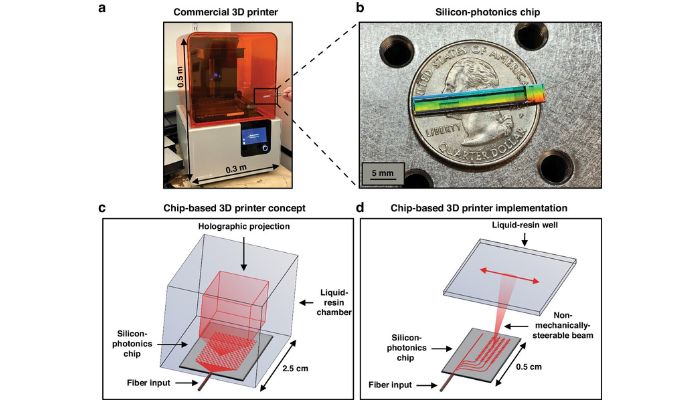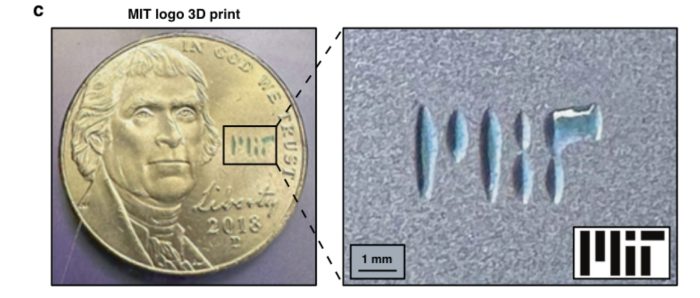The First-Ever Chip-Based 3D Printer Can Fit in the Palm of Your Hand

Last week, researchers from MIT and the University of Texas at Austin announced a significant advancement in 3D printing technology with the first-ever chip-based 3D printer. This device, which is no larger than a coin, represents a significant leap in portable, rapid, and customizable object creation.
The prototype device is built around a millimeter-scale photonic chip that can project reconfigurable beams of light into a well of specially formulated resin. This resin solidifies quickly upon exposure to the light, allowing for the rapid formation of complex shapes and structures. The chip uses an array of microscopic optical antennas to steer the light with precision, eliminating the need for traditional moving parts found in conventional 3D printers.

(a) commercial 3D printer for scale, (b) fabricated photonic chip, (c) (c) proposed system with chip-formed hologram in resin, (d) stereolithography-inspired prototype (not to scale).
Regarding the significance of this achievement, Jelena Notaros, senior author of the paper and Robert J. Shillman Career Development Professor in Electrical Engineering and Computer Science at MIT, explained, “This system is completely rethinking what a 3D printer is. It is no longer a big box sitting on a bench in a lab creating objects, but something that is handheld and portable. It is exciting to think about the new applications that could come out of this and how the field of 3D printing could change.”
The research represents the culmination of advancements in silicon photonics and photochemistry. Notaros’ team at MIT, previously known for their work on light-steering systems, repurposed this technology to emit and control visible light, ideally suited for the specialized resin developed by UT Austin’s Page Group. Leveraging this technology, they successfully constructed the chip-based 3D printer.
Lead author and EECS graduate student Sabrina Corsetti emphasized the significance of this innovation, stating, “Here, we are meeting in the middle between standard photochemistry and silicon photonics by using visible-light-curable resins and visible-light-emitting chips to create this chip-based 3D printer. You have this merging of two technologies into a completely new idea.”

MIT logo printed on a nickel using the chip-based 3D printer.
The research team reports that the potential applications of this technology are very far-reaching. The portable 3D printer could enable on-the-go creation of customized, low-cost items such as fasteners for bicycle repairs or components for medical procedures. Additionally, the printer could have significant use in enhancing the rapid prototyping process, especially for minor and small parts. More notably, however, the team projects future systems where the photonic chip could emit a 3D hologram of light, curing an entire object in one step, greatly amplifying 3D printing’s efficiency and potential. To learn more about this achievement, click here.
What do you think of this first-ever chip-based 3D printer by MIT and UT Austin? Let us know in a comment below or on our LinkedIn, Facebook, and Twitter pages! Don’t forget to sign up for our free weekly newsletter here for the latest 3D printing news straight to your inbox! You can also find all our videos on our YouTube channel.
*All Photo Credits: Massachusetts Institute of Technology






